If you have already experienced making a raised bed in the tropics with more or less long periods of drought you may have had a bad experience, seeing your plants drying very quickly because of this kind of earth shaping speeding up the drying process. In this type of gardening only the addition of an irrigation system can maintain a constant and safe level of humidity.
Hugelkultur allows you to asses this issue in the settlement of your raised bed in a quickly drying context. The organic matter acts as a sponge and keep humidity for weeks and months.
On top of that many tropical plants are used to grow in organic matter and it appears that nitrogen deficiency due to a lack of nitrogen compared to carbohydrates is balanced both;
– by intense tropical bacteriologic activity including nitrogen fixing bacteria and
– by fungi participation, developing well in an organic substrate and bringing nitrogen from close-by vegetation.
In our case we will choose to plant Jack beans to accelerate the nitrogen balancing and prepare the bed for future plantation.
How to
The construction of a raised bed using Hugelkultur is fairly simple, in one word : a lasagna of organic matter and dirt.
You may find some diktat on internet about the exact superposition of trunks, branches, mulch, green material, dirt, etc … but nothing is proven with regards to the best choice on this matter.
It sound however logical that the upper layers are made from finer material to give more room for the young roots to grow and the large size material on the bottom to act as a long term decomposition substrate and nutrient/moisture reserve.
Here are some steps, customized for our context;

A clay layer playing 2 roles; protection from the root system of adjacent trees, canalization and retention of the water flow coming from the rain runoff.
Over time the clay layer will crack and allow permeability between the Hugelkultur and the lower layers of the soil to integrate this small ecosystem with the context still reducing adjacent roots invasion.
4 posts will allow to maintain the pile with vertical sides, increasing the surface of the top area
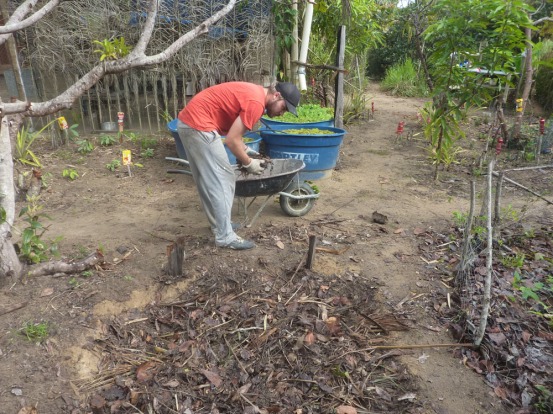
A first layer will act as a sponge for the water runoff and attract worms coming from beneath which will pass the clay layer using the cracks of the drying clay.

Coconut tree trunks are used here for their capability to quickly disaggregate and suck humidity.
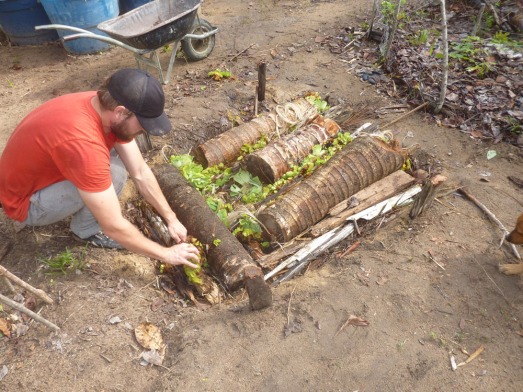
Some green material, rich in living organisms are used to fill the spaces and as an inoculum for bacterial activity.

Some mulch
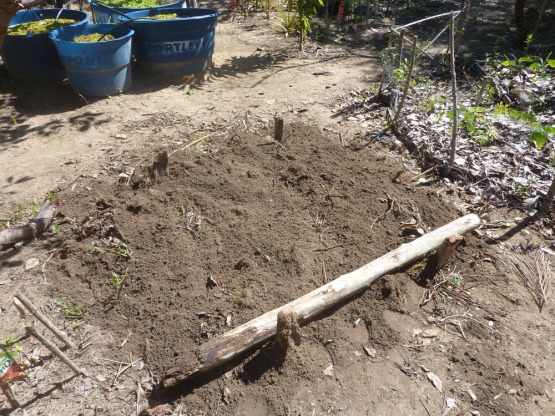
Some soil.
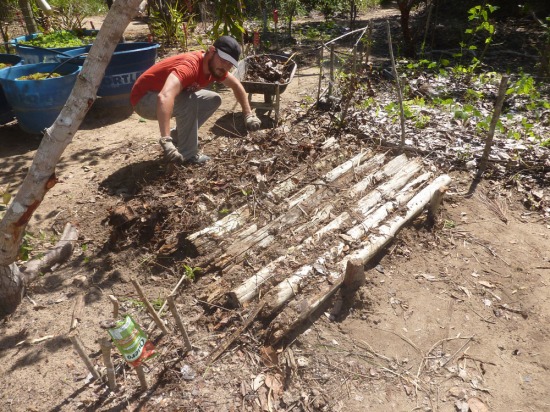
Some smaller however denser timber

Yet another layer of trunks with soil in between.

A green layer (nitrogen and microorganisms) covered with rock dust (minerals)
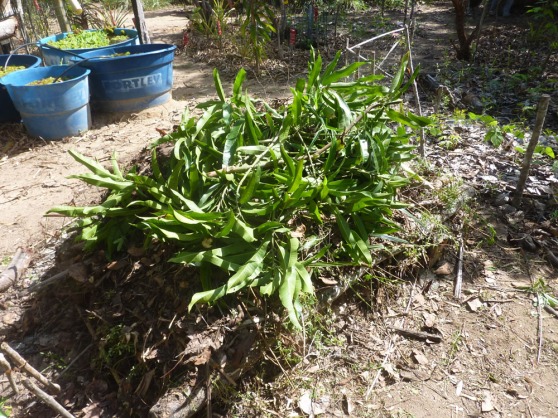
And again a green layer, as a complement of nitrogen.
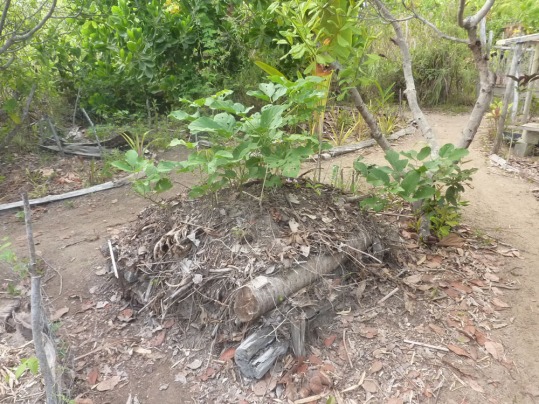
And to finish dirt and mulch with the plantation of Jack Bean which have deep roots and will help nitrogen fixation.
Later, other plants will complement the culture, e.g. passion fruit which will climb to the tree close by, corn and squash. Over time the bed will mature and refine itself, being ready for more fragile and sophisticated plants.
The difference with temperate climate hugel-bed is a much higher proportion of organic matter compared to dirt in order to insure moisture retention and adapt to an ecosystem where carbohydrate degradation is fast.
Higher posts could have been used as buttresses to have vertical side walls until the top and help better contain the mulch on the last layer.
Our strategy with regard to HugelKultur in Zone 1 is to create 2 steps projects, here above being the first phase. The second step will consist in creating clay + building rubble walls to have more permanent hearth-shaping containers, easy to maintain by adding organic matter regularly and allowing to create flat top layer for better access and increased plantation area. In Zone 2 and above the Hugelkultur mounts can remain as is and over time will degrade and merge quickly with the garden ecosystem, improving the global texture of the soil.
A water dripping irrigation system will still be put on the zone 1 raised beds in order to palliate the lack of water. The El Niño episode of 2015 / 2016 is lasting 18 months with 1 or 2 days of rain every 3 months in the south of Bahia where we are located (usually south of Bahia is considered humid tropics). The watering will be reduced since the organic matter acts as a sponge and hold the humidity. In Zone 2 the raised bed will be watered manually only in case of sever drought considering than only cassava and drought resistant plants will be planted there.

I am creating hugelkultar in 3 sided pallet crate, then closing with 1 pallet. 1 pallet underneath for trucking ease. DWARF COCONUT PALMS, some in Wailua, Hawaii, and some on lava in Ocean View on the Big Island.
LikeLike